Service history
Tanu was constructed by Yarrows with the yard number 324 at their yard in Esquimalt, British Columbia and launched in 1968. The ship was completed in September 1968 and entered service that same year. The vessel is registered in Ottawa, Ontario and is homeported at the Canadian Coast Guard base in Patricia Bay, British Columbia. The vessel is primarily tasked with performing fisheries patrols on the Canadian Pacific coast.
In October 2010, Tanu underwent a major refit performed by Allied Shipbuilders of North Vancouver, British Columbia that upgraded the two main engines to decrease emissions, installed three new generators to modernize the electrical generating system, along with new sewage treatment plant, navigation and communication equipment, galley and hospital. The vessel returned to active service in March 2011. [6] [7]
In April 2018, Tanu was among three Canadian Coast Guard vessels that responded to the distress call of the fishing vessel Western Commander in the Hecate Strait. Three of the crew were rescued, with a fourth dying of a heart attack during the event. The 75-year old fishing vessel which had been listing to starboard upon the Coast Guard's arrival, later sank. [8] In July 2018, Tanu was among the Canadian Coast Guard vessels tasked with performing the largest survey of marine mammal populations in British Columbia waters. Tanu was assigned to survey Hecate Strait, Johnstone Strait, the Strait of Georgia and into Juan de Fuca Strait. [9]
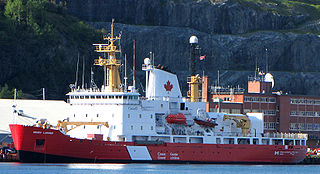
CCGS Henry Larsen is a Canadian Coast Guard Improved Pierre Radisson-class icebreaker serving in the Newfoundland and Labrador region and based in St John's, Newfoundland and Labrador. Entering service in 1988, Henry Larsen is the fourth ship and of an improved design over the rest of the ships in her class. The ship operates in the Arctic Ocean during summer months.

CCGS Samuel Risley is a Canadian Coast Guard icebreaker and buoy tender assigned to the Great Lakes area. Lead ship of her class, the vessel is named after Samuel Risley, the 19th century maritime inspector and first head of Board of Steamship Inspectors for Upper Canada and Ontario. Based in the Great Lakes, CCGS Samuel Risley is responsible for keeping an ice-free passage between Port Colborne, Ontario and Thunder Bay, Ontario.
CCGS Cape Roger is the lead ship of the Cape Roger-class fisheries patrol vessels operated by the Canadian Coast Guard. The ship entered service in 1977 and was assigned to monitor the Atlantic fisheries. During the Turbot War, Cape Roger took part in the detainment of the Spanish fishing trawler Estai. The ship is currently in service.

CCGS Sir William Alexander is a Martha L. Black-class light icebreaker. Entering service in 1987, the vessel is currently assigned to CCG Maritimes Region and is homeported at CCG Base Dartmouth, in Dartmouth, Nova Scotia. The vessel is named after Scottish explorer Sir William Alexander, 1st Earl of Stirling, who was an early colonizer of Nova Scotia.

CCGS Sir Wilfred Grenfell is a Canadian Coast Guard vessel based in Victoria, British Columbia. Designated an "Offshore Ice Strengthened Multi Patrol Vessel", the former offshore supply vessel is named after the medical missionary in Labrador, Sir Wilfred Grenfell. Constructed in 1984–1985, Sir Wilfred Grenfell was purchased by the Canadian Government and converted for Coast Guard service. In 1994, she played an important role in the fishing conflict known as the Turbot War in the Atlantic Ocean.

CCGS Leonard J. Cowley is an ice-strengthened fisheries patrol vessel of the Canadian Coast Guard. The ship entered service in 1984 and is still currently in service. During the Turbot War, the patrol vessel took part in the detainment of the Spanish fishing vessel Estai. Leonard J. Cowley's home port is St. John's, Newfoundland and Labrador.
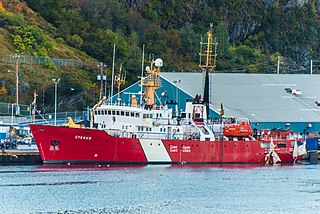
CCGS Cygnus is a Cape Roger-class fisheries patrol vessel of the Canadian Coast Guard. The ship entered service in 1981 and is used to monitor the fisheries along the Atlantic coast of Canada. During the Turbot War, Cygnus was among the Coast Guard vessels sent to monitor the European fishing fleet on the Grand Banks.

CCGS John P. Tully is an offshore oceanographic science vessel in the Canadian Coast Guard operating out of Pacific Region at CGS Base Patricia Bay in Sidney, British Columbia. Prior to 1995, the ship was assigned to Fisheries and Oceans Canada. The vessel entered service in June 1985 with the Department of Fisheries and Oceans on the West Coast of Canada. In 1995, the fleets of Fisheries and Oceans and the Canadian Coast Guard were merged under Canadian Coast Guard command and John P. Tully became a Coast Guard vessel.
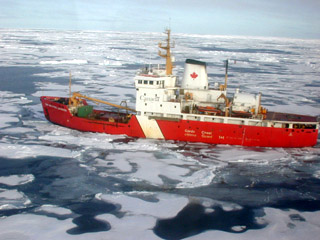
CCGS Sir Wilfrid Laurier is a Martha L. Black-class light icebreaker and major navaids tender of the Canadian Coast Guard. Built in 1986 by Canadian Shipbuilding at Collingwood, Ontario, Canada, she was the last ship constructed there. The ship has been based out of Victoria, British Columbia.
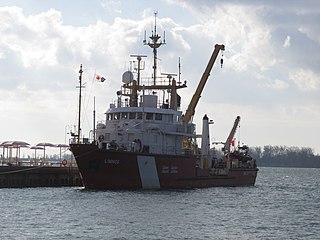
CCGS Limnos is a Canadian Coast Guard coastal research and survey vessel and it is named after the Greek island of Limnos which itself derived from "limni", the Greek word for lake. The ship entered service in 1968 and is currently active. The ship is based on the Great Lakes at the Coast Guard Base in Burlington, Ontario and is used for hydrographic and limnological research.
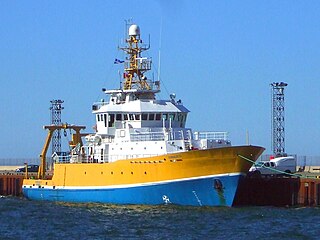
Coriolis II is a Canadian research vessel. She is homeported in Rimouski, Quebec. She is operated by a consortium of five institutions: Institut des sciences de la mer à Rimouski (ISMER), the Université du Québec à Montréal (UQAM), McGill University, the Institut national de la recherche scientifique - Eau, terre et environnement (INRS-ETE) and the Maurice Lamontagne Institute (MLI-DFO). The vessel was constructed in 1990 by Versatile Pacific Shipyards of Esquimalt, British Columbia for the Canadian Coast Guard. Initially named CCGS John Jacobson, the vessel was deployed for search and rescue missions along Canada's coastlines. The Canadian Coast Guard took John Jacobson out of service in 1999 and sold the ship to her current owners in 2001.

CCGS Gordon Reid is an offshore fisheries patrol vessel of the Canadian Coast Guard. The vessel entered service in 1990 on the West Coast of Canada and is still in active service. In 2014, Gordon Reid responded to the distress signal of MV Simushur which had lost engine power off the coast of Haida Gwaii in British Columbia.

CCGS Pierre Radisson is the lead ship of her class of icebreakers. Constructed and operated by the Canadian Coast Guard, the vessel is based at Quebec City on the Saint Lawrence River. The ship was constructed in British Columbia in the 1970s and has been in service ever since. The vessel is named for Pierre-Esprit Radisson, a 17th-century French fur trader and explorer.
CCGS Wilfred Templeman was a Canadian Coast Guard fisheries research vessel that entered service 1981 with the Department of Fisheries and Oceans. In 1995 the Fisheries and Oceans and Canadian Coast Guard fleets were amalgamated and Wilfred Templeman joined the Canadian Coast Guard. The research vessel patrolled the coast off Newfoundland and Labrador. In 2011, the vessel was taken out of service, sold to commercial interests and renamed Blain M.

CCGS Earl Grey is a Samuel Risley-class light icebreaker and buoy tender in the Canadian Coast Guard. Constructed in 1986, the vessel serves a variety of roles, including light ice-breaking and buoy tending, as well as being strengthened for navigation in ice to perform tasking along the shores off the Atlantic coast of Canada. Like her sister ship, CCGS Samuel Risley, she carries a large and powerful crane on her long low afterdeck for manipulating buoys. Earl Grey is the second icebreaker in Canadian service to carry the name.

CCGS Vector is a hydrographic survey vessel in the Canadian Coast Guard. The ship was constructed in Canada and entered service in 1967 as a coastal research vessel on the West Coast. The ship is currently in service, based at Canadian Coast Guard Base Patricia Bay in Sidney, British Columbia.

CCGS George R. Pearkes is a Martha L. Black-class light icebreaker and buoy support vessel in the Canadian Coast Guard. Named for Victoria Cross-winner George Pearkes, the ship entered service in 1986. Initially assigned to Pacific region, the vessel transferred to the Quebec region. George R. Pearkes was assigned to her current deployment, the Newfoundland and Labrador region in 2004.
CCGS Provo Wallis is a Provo Wallis-class buoy tender that served with the Canadian Coast Guard. The vessel entered service in 1969 and was classed as a Medium-endurance Multi-tasked Vessel. Provo Wallis spent the majority of her career on the Atlantic Coast of Canada before transferring to the West Coast. Ice-strengthened, the ship was used mainly for maintaining navaids in shipping lanes. The vessel was taken out of service in 2011 and laid up.

The Samuel Risley-class icebreakers are a class of two icebreakers and buoy tenders constructed for and operated by the Canadian Coast Guard. The two ships are based on offshore supply tugboat design and entered service in the 1980s. Samuel Risley is deployed to the Central Region, operating mainly on the Great Lakes of North America, while Earl Grey is posted to Atlantic Canada, working off the east coast of Canada.
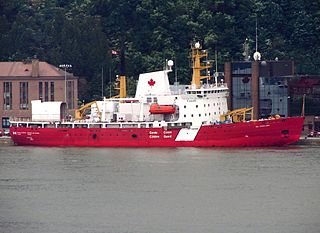
The Pierre Radisson-class icebreakers, also known as R-class icebreakers, are a class of four icebreakers constructed for and operated by the Canadian Coast Guard. The Canadian Coast Guard designates the four ships in the class as medium icebreakers. Built in two phases, the first three ships, Pierre Radisson, Franklin and Des Groseilliers, were built to a common design. The fourth, Henry Larsen was built to a modified design and is considered a subclass, the Improved R-class icebreaker. Franklin was later renamed Sir John Franklin before undergoing a re-design for use primarily as an Arctic research vessel. Upon the vessel's return to service, the ship was once again renamed Amundsen. All the vessels are named for people who sailed through Canada's northern waters. The class operates in the Arctic Ocean in the summer, patrolling, icebreaking and research missions.
















